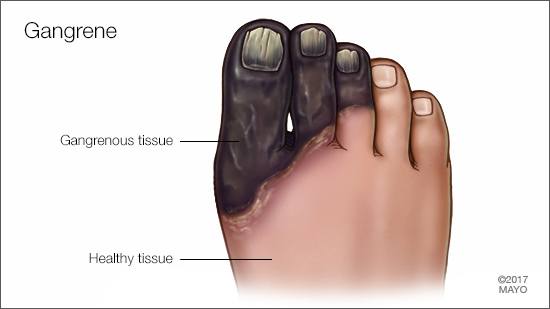-
Mayo Clinic Q and A: Understanding and preventing gangrene
 DEAR MAYO CLINIC: I have heard that a stubbed toe can lead to gangrene in some individuals. Is that true? What are the signs of gangrene, and how can it be avoided?
DEAR MAYO CLINIC: I have heard that a stubbed toe can lead to gangrene in some individuals. Is that true? What are the signs of gangrene, and how can it be avoided?
ANSWER: Gangrene, which refers to tissue death caused by a severe shortage of blood supply or serious bacterial infection, occurs in lower extremities. It is more common in the toes than other parts of the body. Gangrene tends to happen more often among people with peripheral artery disease, a common circulatory problem in which narrowed arteries reduce blood flow to the limbs. People with diabetes and peripheral artery disease are especially vulnerable to complications such as gangrene, because, in addition to poor blood circulation, they often have decreased sensation in their feet due to nerve damage. If an injured toe goes unnoticed and blood supply is inadequate to help heal the wound, tissue death may occur.
Gangrenous tissue typically becomes discolored, ranging from pale purple to black. The skin may become dry, hard and shriveled, with a clear line separating the dead tissue from healthy tissue. If an infection is present, the area may look swollen or form blisters filled with fluid on the skin. There’s often a foul-smelling odor.
These signs and symptoms require immediate care, as they quickly can lead to loss of limbs and death — at times quickly — due to sepsis. Treatment may involve taking antibiotics for infection, re-establishing blood flow to the area and removing the dead tissue.
See your health care provider if you have leg pain or numbness, sores that won’t heal on your feet or legs, or changes in the color of the skin around your legs or feet. Peripheral artery disease, which often accompanies diabetes and coronary artery disease, is strongly associated with smoking.
If you have diabetes, maintain careful control of your blood glucose level, and take good care of your feet. Always wear protective footwear that properly accommodates your feet. Do a daily check for redness, calluses and wounds. If you find any of these problems, treat your feet promptly and adjust your activity. If you’re a smoker, stop. Regular exercise and a healthy diet can keep peripheral artery disease, diabetes and heart disease in check, thus minimizing your risk. (adapted from Mayo Clinic Health Letter) — Dr. Karen L. Andrews, Director, Vascular Ulcer/Wound Healing Clinic, Mayo Clinic, Rochester, Minnesota







